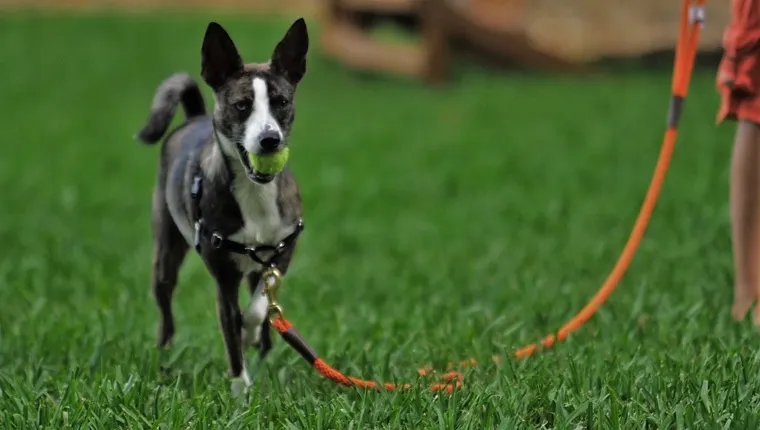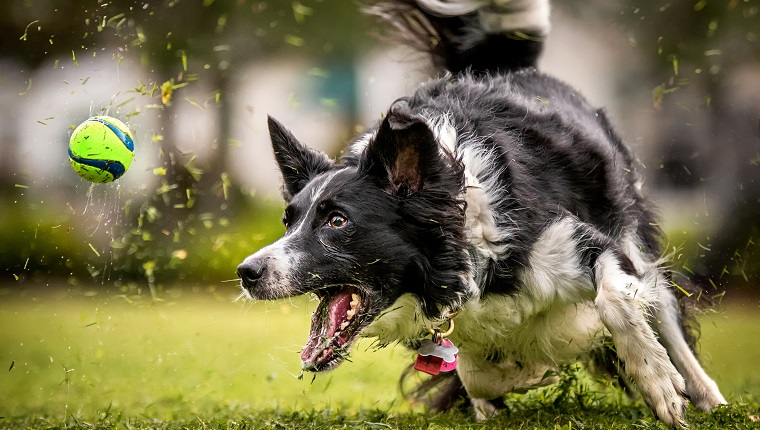It may surprise some dog lovers to learn that our pups don’t all automatically know how to play fetch. Even though it’s a stereotypical dog game, running after a toy and bringing it back doesn’t always come naturally to pooches.
Fetch is a great form of both mental and physical exercise. When structured properly, it’s also a terrific way to practice impulse control and consistent obedience. Structured inappropriately, it can turn into a fun game — for your dog, that is — of keep away!
If your dog doesn’t know how to play fetch, don’t worry. Just about any dog can learn with a bit of training. Follow these tips to develop a fantastic fetcher!
What You’ll Need To Teach Your Dog To Fetch
Before you start, make sure you prepare with the basics.
You’ll need:
- Two toys or balls (or two of the same objects)
- A long line or flexi-leash (this is one of the only times I think about using a flexi; never for walking my dog because they can be dangerous!)
- Your dog should reliably know the “sit” command
- A spare five to 15 minutes for each practice session
Getting Started

Now that you’ve got your supplies and some time, you can start teaching your dog to play fetch. Remember to keep training sessions fairly short and to the point.
If your dog gets distracted and bored, it will be more difficult for them to retain what they’ve learned and stick around for the next practice. Take a break and start again later if you seem to be losing your dog’s attention.
Here are the first steps you should take:
- 1. Attach your dog to a long line or flexi-leash. This will prohibit your dog from grabbing the ball and dashing off away from you. It will also keep them closer and more attentive to you, making for more efficient training sessions.
- 2. Take out one ball or toy and show it to your dog. If necessary, wave it around a bit to excite them, but skip the waving if your dog gets overly excited at the sight of a toy.
- 3. Cue your dog to “sit.”
- 4. As soon as your dog sits, say, “yes!” and toss the ball or toy four to five feet away from you. By keeping the distance short, you can practice a high number of repetitions in a shorter time frame and, thus, teach this behavior more efficiently.
- 5. When your dog collects the ball or toy, calmly praise them, turn your body sideways, slap your thighs and move away a little bit. Encourage your dog to follow/come back to you. (Turning sideways and moving away actually encourages dogs to come, so this is important!)
- 6. As your dog comes back to you, get your second ball or toy out, but keep it from your dog’s view. If your dog does not drop the first ball/toy upon returning, present the second item. Your dog will likely release ball one for ball two!
- 7. As soon as your dog releases the ball or toy from their mouth, say “yes” and toss the item in your hand four to five feet from you.
- 8. As your dog is running after that ball or toy, pick up the first item.
- 9. Repeat steps five through eight again and again!
Getting Rid Of The Second Ball Or Toy
Now that your dog has the hang of chasing down a toy and bringing it back, you can start to phase out the second toy.
Here are the next steps you should take:
- 1. After a few sessions, instead of presenting the second ball to elicit your dog to drop the first ball, just wait your dog out. When your dog comes back to you with ball in mouth, just stand there and look at or away from your dog. Don’t talk, just wait! It might take a few seconds or longer. Wait!
- 2. When they drop the ball, immediately throw the second ball. You are now teaching your dog that, by dropping the ball, they earn the presentation and toss of the second ball. Their actions — dropping the ball — have good consequences, namely another opportunity to chase the ball!
- 3. Once your dog is reliably coming back and automatically dropping the ball upon return, you can stop using the second ball.
Advancing Your Fetch Skills

If your dog has the hang of chasing down a toy a few feet away and can bring it back regularly, then you can raise the challenge to give them a better — and hopefully more fun — mental and physical workout.
Here are some ways to up the difficulty to keep your dog stimulated:
- 1. Begin to increase the distance that you are throwing the ball.
- 2. Remove the leash only once you know that your dog will safely return to you.
- 3. Begin adding obedience commands in between each repetition, such as cuing your dog to sit or lie down in between each toss. Your dog is now “earning” and being rewarded with each and every toss.
With these techniques and plenty of consistent repetitions, your pup will be reliably fetching and having a blast playing this quintessential dog game. Fetch is a great way to promote happiness and healthiness in your dog, and it can even strengthen your bond.
Good luck! Have fun!
Have you ever taught a dog how to play fetch? Do you have any helpful tips and tricks? Let us know in the comments below!









